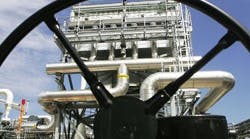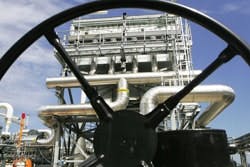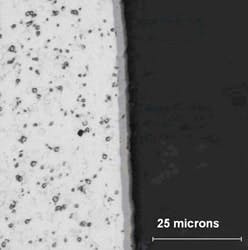The rapid drop in energy costs from historic highs and a growing recession aren’t blunting the chemical industry’s efforts to reduce energy consumption. “We regularly survey our customers to find out what their main issues are. In the chemicals industry, the focus is still very much on energy management and efficiency,” says Vikas Dhole, vice president engineering product management for AspenTech, Burlington, Mass.
“Feedstock and energy make up about 70% of costs in the bulk chemical processes and the monthly energy bills for these companies are still huge. So any saving will have a very big impact,” adds Elinor Price, the company’s director of product marketing.
AspenTech has identified three different energy-improvement opportunities for the chemical industry: real-time optimization, utilities and design.
“Real-time optimization allows operators to be more agile. They are able to continuously maximize margins, which improves the overall business and makes it more robust,” says Dhole. He points to a long-term project with Dow’s North American operations that has yielded $175 million in savings over the last four years. Each plant typically is getting an energy benefit of 3% to 5%.
“Dow regard this as a differentiator for their whole business. They are getting an incredible return. So in terms of optimized technology, this is definitely best practice,” notes Price.
The massive DSM/Sabic site at Geleen, The Netherlands, provides a potent example of a recent success in utilities management. Here, a centralized utility system generates the energy needed for the site’s processes. The challenge was to reduce a nine-figure annual energy bill in a country where energy is one of the most expensive commodities for chemical producers.
“Our AspenUtility suite allowed fundamental modeling and optimization of the utilities system, a holistic site-wide approach that made it much easier for the company to better understand its different processes and improve long-term optimization,” explains Dhole.
Figure 1 -- Success Story: DSM Geleen
has increased production capacity and
reduced emissions while achieving steam
energy savings.
Source: DSM.
DSM Geleen reported benefits of €2.5 million in the first year of operations and, since then, a 3%-to-4% reduction in site-wide energy bills on an ongoing basis (Figure 1).
A project for the Samsung Total Aromatic Complex in Daesan, Korea, illustrates the third point. Or, as Dhole puts it, “The scope for energy savings is very much greater when you move from optimization to design.”
Here the company’s modeling and energy analysis software played an important role, particularly for studying the complex’s energy-intensive distillation columns. It led to 12 projects, producing savings equivalent to about $12 million per year — including a more than 20% cut in energy costs.
Seconding the Opinion
The industry’s quest to boost energy efficiency isn’t flagging, agrees Brendan Sheehan, senior marketing manager for chemicals and energy for Honeywell Process Solutions, Phoenix, Ariz. “Although feedstock is cheaper now, we are not seeing a falloff in interest in improving energy efficiency. This is because margins are very tight at chemical plants and the big fall in demand means that people are not pushing throughput as hard. Bear in mind that the cost of natural gas accounts for more than 80% of the operating cost of an ammonia plant. So anything you can do to reduce energy use is important,” he explains.
“We commonly hear from customers that they expect energy prices to pick up as the global economy picks up. They don’t think it will go to the $140/bbl that we saw last year but the perception is that $60–$70/bbl may not be unexpected. On top of this, the continued focus on carbon emissions in Europe — the regulations for which are certainly going to get tighter — really drives the need for improved energy efficiency,” he adds.
Its strategy involves capturing energy data from plants to create energy models that demonstrate the difference between what plants are doing and what they could be doing. This performance assessment serves to identify possible solutions.
For example, the company has installed its Profit Suite collection of advanced process control and optimization products at the Yeochun ethylene plant at Yeosu, South Korea. Here, 17 different controllers linked by an optimizer and a nonlinear model predict the yield coming from the site’s seven furnaces. The result has been a 3% increase in production and a 3.25% decrease in energy consumption, which was essentially achieved by improving furnace efficiency and reducing steam consumption in downstream processes.
“The project paid back in under five months. In ethylene plants generally it would be typical for this type of project to increase ethylene production by between 1% and 5% and reduce energy consumption by between 2% and 4%,” notes Sheehan.
Emissions Trading
Sheehan’s point about European carbon emissions highlights a key issue on the continent at the moment following the adoption of a new European Union (EU) package of measures to tackle climate change. Alterations made to the original draft have failed to quell concerns in the chemical industry about the lack of support for its investment in energy efficient processes such as combined heat and power (CHP) plants.
The planned auctioning of emissions certificates poses a threat to the competitiveness of energy-intensive industries because they are unable to pass on higher costs to their customers, warns Harald Schwager, executive director of BASF, Ludwigshafen, Germany.
“The result will be that energy-intensive production and the associated jobs will move to non-European countries where climate protection and — more so — the cost of carbon dioxide certificates or carbon dioxide taxes is not an issue. This is not the way to serve the interests of climate protection,” he says.
Figure 2 -- A significant turn:
EU plans to boost energy efficiency
could cost BASF up to €600 million/yr
($792 million) for emissions certificates.
Source: BASF.
This could cost EU industry €9 billion/yr (∼$12 billion), Schwager points out, with BASF alone facing a bill of as much as €600 millions/yr (∼$792 million) for emissions certificates (Figure 2).
The North-East Process Industry Cluster (NEPIC), which represents more than 500 chemical, pharmaceutical and biotech companies across the U.K.’s North East chemical heartland, also faults the new agreement for not allowing free carbon credits to be given to companies that generate their own electricity using CHP plants. So, for example, a £26-million (∼$37 million) CHP plant installed at Wilton by Sembcorp Utilities U.K. won’t be recognized.
“We think this is a real opportunity missed. Any project to make a significant improvement to climate change will be a huge capital investment. Such investments are not properly supported by current U.K. government grant support schemes and NEPIC companies have been lobbying intensively to make this point,” notes Stan Higgins, NEPIC CEO.
Sembcorp’s CHP plant, one of two it owns at Wilton, distributes steam to chemical plants around the area. “We understand the steam output will get some free allowances for the first few years but that will diminish over time. Unfortunately, the power, which is produced at the same time as the steam, will not get any free allowances, which could mean higher costs,” says a company spokesman.
Carbon Leakage
At the same time, the risk of producers shifting factories, jobs and emissions to other parts of the world — so-called carbon leakage — is generating heated debate within the EU.
Carbon leakage is being blown out of proportion, contends Karsten Neuhoff , an economist at Cambridge University, Cambridge, U.K. “The industry claim to the extent that they argue [that climate policy] has a big economic impact I think is exaggerated. There is no evidence so far that [industries] responded to a more ambitious European climate policy by thinking about moving somewhere else,” he says.
Jean-Pierre Clavel, president of Eurogypsum, a Brussels-based trade association of European manufacturers of gypsum-based products, counters that carbon leakage already is occuring. “[Carbon trading] creates for investment decisions an uncertainty. My business is €400 million [∼$528 million] and it employs 14,000 people in the world with, let's say, more than half of it in Europe. So we look at the additional cost of this and it is very significant. It will be about 10% of our profit in a good situation. Right now, with the profit going down due to the depression, it will be 20% to 25%.”
A further sign of Europe’s ongoing focus on energy-related matters came to the fore in early January when the European Parliament’s Industry, Research and Energy committee called for a Europe-wide reduction in oil demand of more than 50% by 2050.
Finer Focus
While industry and government don’t share the same viewpoint on such broad energy-related issues, they do seem to agree on the need for more research on specific areas that can help save energy. For instance DuPont, Wilmington, Del., is calling for greater collaboration between industry, government and universities to accelerate the development of sustainable alternative energy solutions.
“Universities and national laboratories in the United States have a critical role to play in addressing our serious energy challenges,” says Uma Chowdhry, the firm’s senior vice president and chief science and technology officer. “The challenges we face can and must be solved.”
Speaking at the opening of the new University of Delaware Energy Institute, she called on the federal government to set a long-term energy strategy, increase investment in energy research and development, and take bold actions to secure the country’s energy future.
Chowdhry wants the federal government to further encourage the sort of collaborations that already are occuring.
For example, researchers at the U.S. Department of Energy’s (DOE) Ames Laboratory, Ames, Iowa, are working with other research labs, universities and industrial partners to develop low-friction nanocoatings.
“If you consider a pump, it has a turbine that moves the fluid,” says Bruce Cook, an Ames scientist and co-principal investigator on the four-year, $3-million project. “When the rotor spins, there’s friction generated at the contacting surface between the vanes and the housing, or stator. This friction translates into additional torque needed to operate the pump, particularly at startup.”
Applying a coating to the blades that would reduce friction and increase wear resistance could offer significant savings. According to Cook, U.S. government calculations show that a modest increase in pump efficiency resulting from use of these nanocoatings could reduce U.S. industrial energy usage by 31 trillion Btus annually by 2030, a savings of $179 million/year.
Figure 3 -- Nanocoating: A 2 micron
to 3-micron-thick coating appears as
thin dark strip on steel substrate,
which looks mottled because of carbon
inclusions.
Source: Ames Laboratory.
The coating that Cook is investigating is a boron-aluminum-magnesium (AlMgB14) ceramic alloy that reportedly cuts friction by at least an order of magnitude compared to an uncoated surface (Figure 3).
Meanwhile, four projects at Oak Ridge National Laboratory (ORNL), Oak Ridge, Tenn, to improve industrial energy efficiency have won funding from DOE’s Industrial Technologies Program.
The potential is huge, considering that the industrial sector accounts for about one-third of total U.S. energy consumption. “Working with industry, we are confident that we can reduce the amount of energy consumed and increase productivity through new technologies,” says Craig Blue, manager of the Industrial Technologies Program for ORNL.
One project aims to develop advanced materials and designs to boost the efficiency of biomass-fired boilers by reducing the corrosion rate of superheater tubes. The second, which includes ExxonMobil among its partners, focuses on developing a field-deployable system for friction stir welding, a process that uses 80% less energy than standard welding, to cut costs of on-site oil and gas pipeline construction.
Researchers worldwide also are focusing on achieving better energy efficiency in that key element of chemical manufacturing, the reactor. For instance, the Netherlands Organization for Scientific Research (NOSR), The Hague, is partnering with BASF Nederland, DSM Research, Lummus Technology and Shell Global Solutions International on foam reactor research.
NOSR scientist Charl Stemmet is leading the project. He’s investigating a new structured support for catalysts for use in gas/liquid reactors. This involves a highly porous solid foam material that has up to 97% open space available — the larger the surface area, the greater the production per unit reactor volume.
Stemmet first examined the flow behavior of gas and liquid and experimentally determined the design equations. He then compared the foam reactor with the current standard for gas/liquid reactions using a solid catalyst — a so-called packed bed of stacked catalyst particles.
The foam reactor requires a volume 1.5 times larger than that of the packed bed for the same gas and liquid flows and same production rate. However, the energy efficiency of the foam reactor is ten times higher than that of the packed bed, he says.
Seán Ottewell is Chemical Processing's editor at large. You can e-mail him at [email protected].





